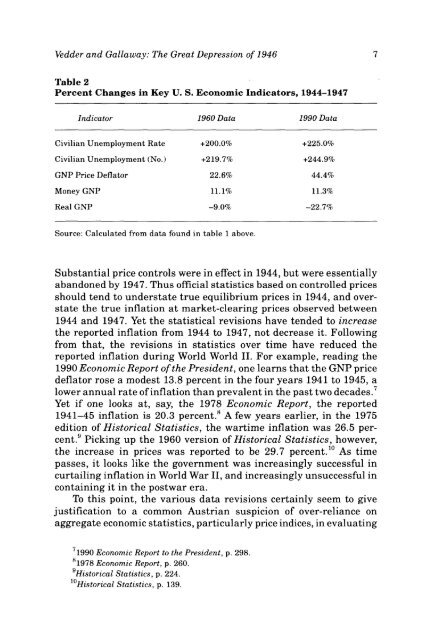Review of Austrian Economics - The Ludwig von Mises Institute
Review of Austrian Economics - The Ludwig von Mises Institute
Review of Austrian Economics - The Ludwig von Mises Institute
Create successful ePaper yourself
Turn your PDF publications into a flip-book with our unique Google optimized e-Paper software.
Vedder and Gallaway: <strong>The</strong> Great Depression <strong>of</strong> 1946<br />
Table 2<br />
Percent Changes in Key U. S. Economic Indicators, 1944-1947<br />
Indicator<br />
1960 Data<br />
1990 Data<br />
Civilian Unemployment Rate<br />
Civilian Unemployment (No.)<br />
GNP Price Deflator<br />
Money GNP<br />
Real GNP<br />
+200.0%<br />
+219.7%<br />
22.6%<br />
11.1%<br />
-9.0%<br />
+225.0%<br />
+244.9%<br />
44.4%<br />
11.3%<br />
-22.7%<br />
Source: Calculated from data found in table 1 above.<br />
Substantial price controls were in effect in 1944, but were essentially<br />
abandoned by 1947. Thus <strong>of</strong>ficial statistics based on controlled prices<br />
should tend to understate true equilibrium prices in 1944, and overstate<br />
the true inflation at market-clearing prices observed between<br />
1944 and 1947. Yet the statistical revisions have tended to increase<br />
the reported inflation from 1944 to 1947, not decrease it. Following<br />
from that, the revisions in statistics over time have reduced the<br />
reported inflation during World World II. For example, reading the<br />
1990 Economic Report <strong>of</strong> the President, one learns that the GNP price<br />
deflator rose a modest 13.8 percent in the four years 1941 to 1945, a<br />
lower annual rate <strong>of</strong> inflation than prevalent in the past two decades. 7<br />
Yet if one looks at, say, the 1978 Economic Report, the reported<br />
1941-45 inflation is 20.3 percent. 8 A few years earlier, in the 1975<br />
edition <strong>of</strong> Historical Statistics, the wartime inflation was 26.5 percent.<br />
9 Picking up the 1960 version <strong>of</strong> Historical Statistics, however,<br />
the increase in prices was reported to be 29.7 percent. 10 As time<br />
passes, it looks like the government was increasingly successful in<br />
curtailing inflation in World War II, and increasingly unsuccessful in<br />
containing it in the postwar era.<br />
To this point, the various data revisions certainly seem to give<br />
justification to a common <strong>Austrian</strong> suspicion <strong>of</strong> over-reliance on<br />
aggregate economic statistics, particularly price indices, in evaluating<br />
7 1990 Economic Report to the President, p. 298.<br />
8 1978 Economic Report, p. 260.<br />
9 Historical Statistics, p. 224.<br />
^Historical Statistics, p. 139.

















